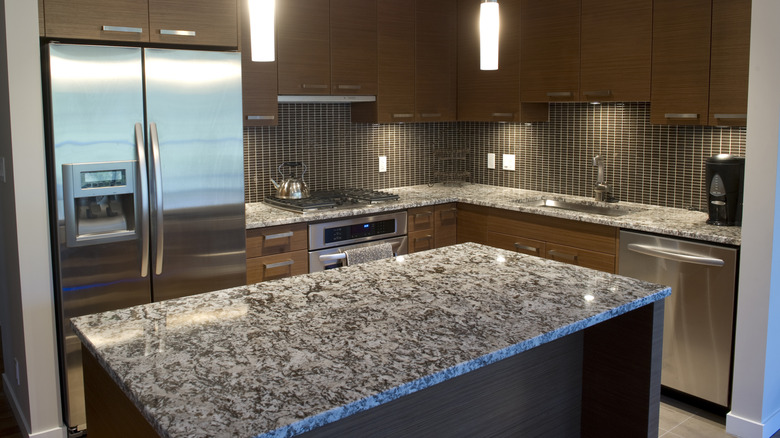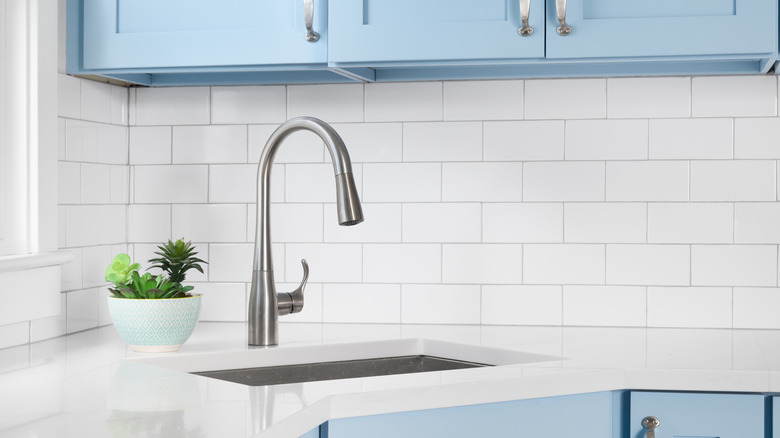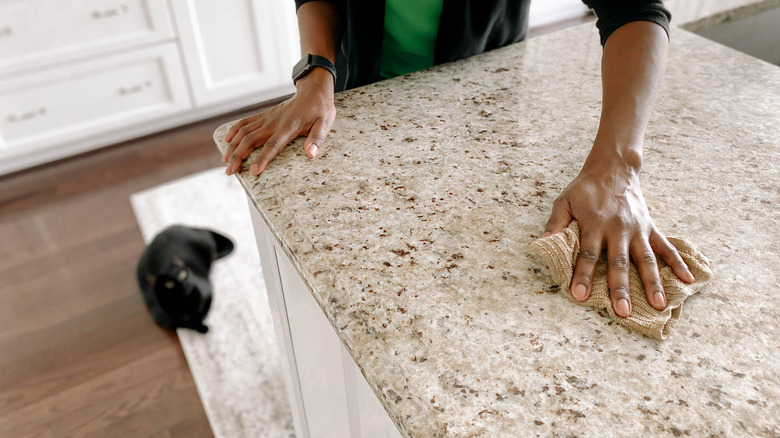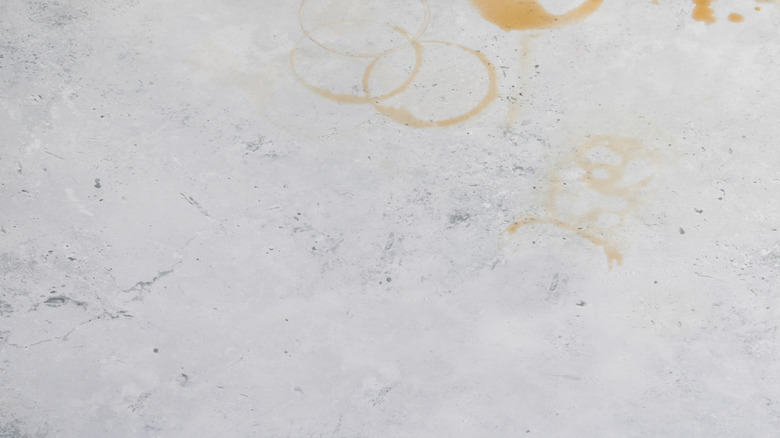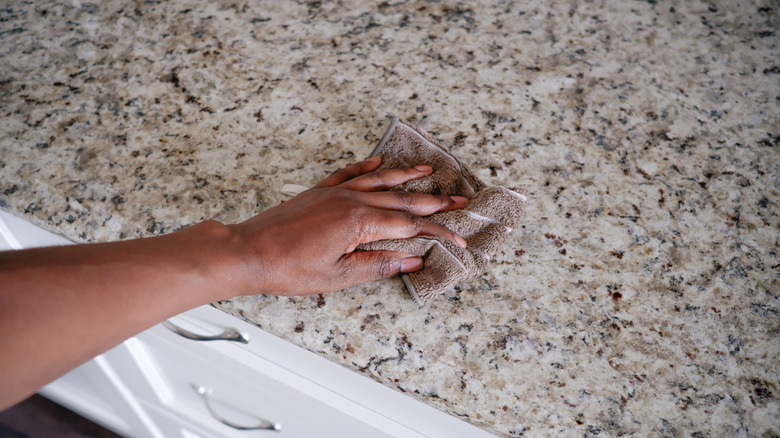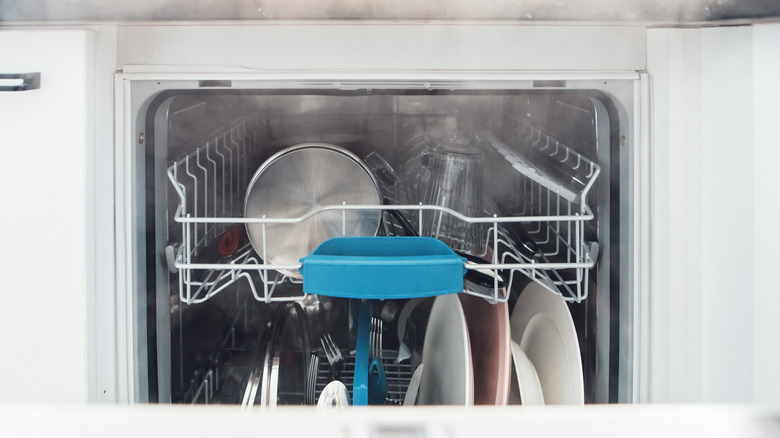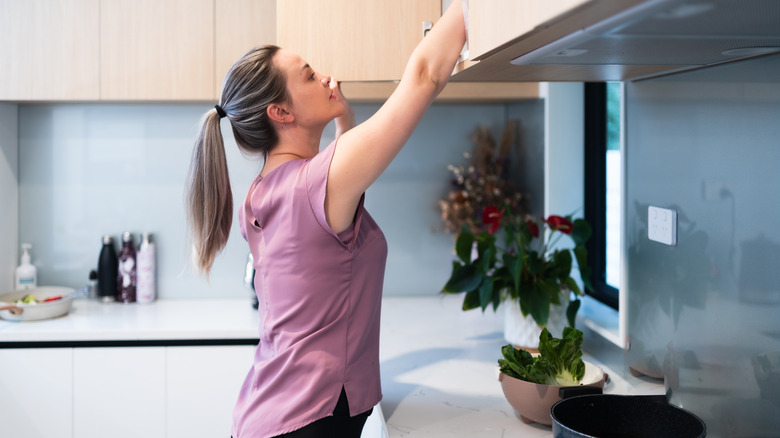Maintenance Mistakes That Are Ruining Your Granite Countertops
We may receive a commission on purchases made from links.
Granite countertops are known to be durable stone options that require minimal maintenance, but this doesn't mean there isn't some care required. Blunders like using the wrong cleaning products or leaving certain items out can lead to etching, staining, and other deformities. Although some blemishes on your stone counters are easy to repair, extensive damage may require replacing a section or even the entire countertop. Given the typically higher cost of granite countertops, it's important to not only keep up with general maintenance but also to do your best to prevent issues that could compromise their longevity.
Thankfully, many of these typical maintenance mistakes are easily avoidable, so you won't need to change up your routine too much. With so many good qualities, like heat resistance and durability, granite countertops are worth the extra bit of effort to maintain their condition. All you'll need is a little knowledge, a slight adjustment to your care routine, and mindfulness of common issues to keep your stone countertop a beautiful feature in your home. Here are some common mistakes to avoid, along with tips to keep your granite countertops as stunning as the day they were installed.
Not regularly resealing your countertops leaves them vulnerable to damage
Although granite is naturally durable, sealing it adds an extra layer of protection that makes it even easier to maintain. What many people don't realize about granite is that it's actually a porous stone. The tiny spaces between the mineral grains aren't visible to the naked eye, but you'll quickly notice them if a spill soaks into the countertop. Not only does its porousness leave your counters susceptible to staining, but it also allows bacteria to settle into the surface. Making sure your countertops are sealed and resealed when necessary will make them hygienic and easier to clean.
Since every granite slab is unique, the level of porosity can vary from one countertop to another. To determine if it's time to seal your granite countertop, perform a simple water test. Pour ¼ cup of water onto the surface and note how long it takes to be absorbed. A properly sealed countertop will repel water for at least 30 minutes, while an unsealed surface will darken almost immediately. If the water seeps in within five minutes, this indicates the need for several layers of sealer which you should repeat every three to five years. If it takes 10 to 20 minutes, a single layer of sealer can typically protect your countertop for a few more years. Repeat the test annually so you'll always know if your counter is ready to be resealed or not.
Using harsh cleaning products can damage the seal
Using harsh cleaners or coarse cleaning supplies can damage granite countertops. While the stone itself may be able to withstand a tough scouring pad, scrubbing with abrasive tools can slowly strip away the sealer. Common acidic household cleaning products, like bleach, can eat away at the sealer as well, making the granite vulnerable to etching or staining. While you may avoid harsh household brands, DIY cleaners made with lemon juice, vinegar, or other liquids with high acidity can cause the same damage. If the products seep into the granite, it can etch or stain the stone, which can be costly to repair.
Typically, all you need to clean and disinfect granite countertops is warm, soapy water. Rather than using wire cleaners or sharp brushes, opt for a softer material like a microfiber cloth. Dip the cloth in warm water with a small amount of dish soap and wipe down your counter entirely. Once the counters are clean, remove any residue by going over it again with just water; otherwise, it'll leave behind a film. To get a deeper clean, choose a pH-neutral cleaner designed for porous stones like granite. Products like Weiman granite and stone disinfectant will kill germs and break down grime without damaging your granite countertops.
Letting spills sit for too long can lead to staining
It doesn't matter if you have granite countertops in your kitchen or bathroom; messes are inevitable. Whether you're cooking for your family after a long day at work or in a hurry to get ready before going out at night, it's easy to spill something small and think, "I'll get to it later." However, you don't want that coffee ring or drop of lip gloss to sit for too long. The longer the substance sits on the surface, the more likely it is to seep in and cause hard-to-remove stains. This is especially true if the sealer has worn down, but it's always best to get in the habit of wiping up spills right away.
Although these busy areas of your home may seem impossible to make spill-proof, there are a few habits that can help prevent messes. Use coasters when setting drinks on your counters. Consider placing a tray or mat under your beauty products so any airborne powder or makeup drops land on a surface that can be easily wiped down. If something does spill, use a wet cloth with warm, soapy water to clean it up as soon as you notice. And as noted above, resist the temptation to scrub or use harsh chemicals to remove a stain. When in doubt, contact your manufacturer for guidance.
Failing to clean granite regularly can make your counters look dull
Even if you're good about wiping up spills or running a cloth over the area you used last, you'll still want to implement a regular cleaning schedule. Like any surface of the home, dust and debris can quickly build up. Over time, this will cause your once brand-new-looking countertop to lose its sparkle. There are three main components that come into play when maintaining the integrity and cleanliness of your granite countertops: dusting, cleaning, and polishing.
Determining the perfect cleaning schedule for your home depends on how often you're using your counters. If you're preparing meals for a large family several times per day, you'll likely need to clean more often than one person who's rarely in the kitchen. Dusting daily is a quick and easy way to prevent crumbs or dust from sitting around and going unnoticed. On days you use your countertops for cooking, getting ready, or other daily habits, use soapy water to clean the entire area. Make sure to use a dry cloth to dry the area to prevent water stains. To keep the granite sparkling, it's recommended to polish your countertops weekly with a product like Stone Care International's 3-in-1 spray that can clean, polish, and protect the granite surface. This can restore its shine while helping to resist staining.
Neglecting to protect your counters from condensation can cause water stains
While granite countertops are water-resistant, it doesn't mean they are immune to water damage. As noted earlier, granite is porous, and even water can cause staining. So, if you have problems with condensation from a dishwasher or use the same spot for drinks like iced coffee, it could lead to discoloration over time. Although water is transparent, most tap water contains minerals like calcium and magnesium. When it repeatedly seeps into the tiny pores of granite, these mineral deposits can build up, resulting in unsightly water spots.
If a ring forms around a drinking glass you set on the counter, drying the area with a microfiber cloth may do the trick. Hard water stains, like those that result from regular dishwasher condensation, can be a little trickier to eliminate. One way to remove water stains from granite countertops is to mix water and baking soda to form a paste. Once you have enough to cover the spot, use a soft-bristled brush to gently work out the stain. Rinse the area with water before using a fresh, dry cloth to dry the surface completely. To prevent future incidents, use coasters underneath any drinks. If the issue stems from your dishwasher, check the seal for any damage, as faulty seals can lead to excess condensation. If not, try pulling the dishwasher out slightly to allow the vent to direct moisture outward rather than toward your countertops.
Setting hot pans on granite can cause discoloration over time
Although granite is a favored type of countertop that can withstand heat, repeated exposure can harm the surface over time. Experts suggest that repeated high heat in one area might trigger changes in the stone's composition, leading to discoloration. A 2021 study from the Journal of Applied Geophysics showed that granite's thermal properties, including color, roughness, and heat conductivity, change significantly at temperatures above 750 degrees Fahrenheit.
Although the average cookware is unlikely to reach such high temperatures, it's possible that lower but hot temperatures could cause minor effects, such as discoloration or subtle changes in surface texture, especially with repeated exposure. In any case, the sealer is not built to withstand extreme heat. Heat from hot pans off the stove or a dish from the oven can wear down the protective layer, making it more vulnerable to absorbing spills that lead to staining.
While relying on granite's heat resistance may be tempting, it's best to use a pot holder or trivet to protect your granite countertops from exposure to high heat. Additionally, by letting the barrier absorb the excess heat, you'll have less of a safety risk as well. It only takes a few minutes for the stone to absorb the heat, so someone could unknowingly touch the area after the dish is removed and risk getting burned.
Leaning on the edge will make your counter crack over time
Don't be fooled by granite's durability; it's still possible to break this tough stone. Leaning, standing, or sitting on the edge of your granite countertop can weaken the area over time and may even lead to it cracking. The edges are especially vulnerable because more support towards the center, paired with the lack of support on the edge, causes opposing pressure that creates a stress point. Similarly, storing large appliances or putting heavy groceries on the edge could have the same effect over time. One reason granite will crack under pressure is due to its flexibility — or lack thereof. Unlike other countertop materials, like laminate, this stone doesn't bend under concentrated weight. While manufacturers can sometimes repair the cracks, it can be a costly fix.
Don't lean, stand, or sit on the edge to avoid cracking your beautiful granite countertops. Instead, use a step stool to reach items on taller shelves and do your best not to lean on your counters for extended periods of time. While gently resting your arms on your counters for a quick moment likely won't be enough to damage your countertop, it's best to try to break the habit. Additionally, place large appliances, like microwaves, toward the back of your counters and set groceries down in the center to keep the weight evenly distributed.
Storing heavy cookware overhead risks drops that can crack granite countertops
Between dishes, appliances, and other cooking gadgets, determining how to organize your kitchen can be a bit of a challenge. While it may seem reasonable to store rarely used items in the overhead cabinets, you may want to save that space for lighter objects. Just as you don't want to apply weight to the edge of your granite countertops, you don't want to accidentally drop heavy appliances on them, either. If the item falls toward the edge, it could cause cracking similar to leaning or sitting or sitting on it. Even if it lands toward the center of the countertop, the impact could leave scratches or chipping behind.
Rather than storing items in shelving above your granite countertops, opt for bottom storage for heavier appliances. If you don't have room to keep everything underneath your counters, consider using a sturdy storage cart that you can store elsewhere, especially if they aren't everyday items. Use extra caution when handling anything heavy, and set it down gently on your countertop. Accidents happen, but being cautious will help prevent damage and potentially expensive repairs.
